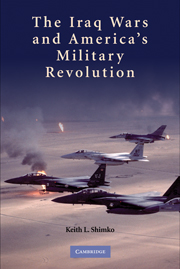Book contents
- Frontmatter
- Contents
- Acknowledgments
- 1 Military Revolutions and the Iraq Wars
- 2 From Vietnam to Iraq – The Rebirth of American Military Power and the Origins of an RMA
- 3 The First Iraq War, 1991 – A Revolution Dawns?
- 4 The Iraqi Interregnum, 1991–2000
- 5 Afghanistan and the Second Iraq War, 2001–2003 – A Revolution Confirmed?
- 6 The Third Iraq War, 2003–? – A Revolution Denied?
- Conclusion: The Future of America's Military Revolution
- Index
- References
2 - From Vietnam to Iraq – The Rebirth of American Military Power and the Origins of an RMA
Published online by Cambridge University Press: 05 June 2012
- Frontmatter
- Contents
- Acknowledgments
- 1 Military Revolutions and the Iraq Wars
- 2 From Vietnam to Iraq – The Rebirth of American Military Power and the Origins of an RMA
- 3 The First Iraq War, 1991 – A Revolution Dawns?
- 4 The Iraqi Interregnum, 1991–2000
- 5 Afghanistan and the Second Iraq War, 2001–2003 – A Revolution Confirmed?
- 6 The Third Iraq War, 2003–? – A Revolution Denied?
- Conclusion: The Future of America's Military Revolution
- Index
- References
Summary
The First Iraq War
Even those inclined to view the 1991 Iraq War as a turning point in the history of warfare concede that this is a matter of legitimate debate, a proposition about which reasonable analysts can disagree. That the war was a turning point for the American military, however, seems almost incontestable. As American and coalition forces gathered in the Arabian Desert in the winter of 1991 to do battle with Iraq, memories of Vietnam and the self-doubt the war engendered were never far from the surface. The outcome in Vietnam had shaken the U.S. military to its core, and the recovery over the subsequent decade and a half had been difficult and sometimes painful. Some may have seen the 1991 Iraq War as a test of abstract theories of changing warfare, but for the American military the stakes were less esoteric. The war provided an opportunity for institutional redemption, a chance to finally exorcise the ghosts and demons of Vietnam. It was certainly a surprising opportunity, and not merely because of the near universal failure to anticipate the Iraqi invasion of Kuwait. Throughout much the 1980s, the United States viewed Iraq as something of an ally, a bulwark against the spread of Iranian fundamentalism and influence. The unexpected nature of the 1991 Iraq War reminds us that nations and their militaries do not always enjoy the luxury of fighting the opponents for whom they prepared and trained.
- Type
- Chapter
- Information
- The Iraq Wars and America's Military Revolution , pp. 26 - 52Publisher: Cambridge University PressPrint publication year: 2010



